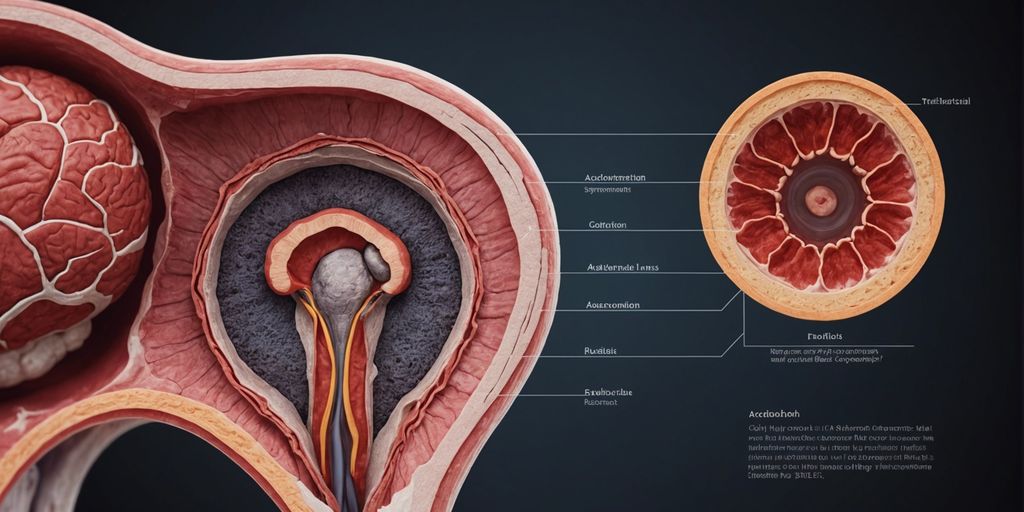
Understanding Adenomyosis: Stages and Symptoms
Share
Adenomyosis is a gynecological condition where the cells lining the uterus grow into the uterine wall, causing the uterus to enlarge. This abnormal growth often leads to painful and heavy periods and can result in fertility issues, making it a significant concern for women of reproductive age. Understanding the stages and symptoms of adenomyosis is crucial for early diagnosis and effective treatment.
Key Takeaways
- Adenomyosis progresses through four stages, each with varying symptoms and levels of uterine tissue infiltration.
- Early symptoms of adenomyosis may be subtle, making early diagnosis challenging but crucial for effective management.
- As adenomyosis progresses, symptoms such as menstrual pain, heavy bleeding, and pelvic discomfort become more pronounced.
- Severe adenomyosis can significantly impact daily life and may require specialized gynecological care and aggressive treatment plans.
- Timely medical consultation and personalized treatment approaches are essential to manage symptoms and prevent complications.

Early Manifestations of Adenomyosis
Subtle Symptoms in Initial Stages
In the initial stage of adenomyosis, the infiltration of endometrial tissues into the uterine wall is minimal. Symptoms at this stage are often mild or non-existent, making early detection challenging. However, any unusual menstrual discomfort should not be overlooked. Prompt consultation with a gynecologist is crucial at this stage, as timely intervention can significantly impact the progression of the disease.
Challenges in Early Diagnosis
Early diagnosis of adenomyosis is fraught with challenges due to the subtlety of symptoms. Many women may dismiss mild menstrual discomfort as normal, delaying medical consultation. The lack of specific symptoms necessitates a high index of suspicion and often requires advanced diagnostic techniques for confirmation.
Importance of Early Medical Consultation
The importance of early medical consultation cannot be overstated. Early intervention can prevent the progression of adenomyosis to more severe stages. Women experiencing any form of menstrual irregularity or discomfort should seek medical advice promptly. Utilizing specialized period underwear for women, such as leakproof underwear, can also help manage symptoms effectively during this stage.
Progression to Moderate Adenomyosis
As adenomyosis advances to the second stage, the infiltration becomes more pronounced, affecting a larger portion of the uterine tissues. This stage is often marked by heavier periods and increased menstrual pain. Additional symptoms may include bloating and discomfort during intercourse. Seeking medical advice from a trusted gynecology clinic is strongly recommended if you experience these symptoms.
Severe Adenomyosis: Clinical Features
Intensified Symptoms and Daily Life Impact
In the severe stage of adenomyosis, symptoms become significantly more intense, often leading to a substantial impact on daily life. Menstrual pain may escalate to a debilitating level, and there is typically an increase in menstrual flow. Other symptoms may include chronic pelvic pain and discomfort during intercourse. Immediate medical attention from experienced gynecologists is crucial at this stage.
Diagnostic Techniques for Severe Adenomyosis
Accurate diagnosis of severe adenomyosis often requires advanced imaging techniques. Transvaginal ultrasound and magnetic resonance imaging (MRI) are commonly used to identify the extent of tissue infiltration and uterine distortion. These diagnostic tools are essential for developing an effective treatment plan.
Role of Specialized Gynecological Care
Specialized gynecological care is vital for managing severe adenomyosis. Gynecologists with expertise in this condition can offer personalized treatment plans that may include pharmacological approaches, surgical options, and supportive therapies. The goal is to alleviate symptoms and improve the patient's quality of life. For instance, using leakproof underwear can help manage heavy menstrual bleeding, providing comfort and confidence during daily activities.
Advanced Adenomyosis: Complications and Management
Chronic Pelvic Pain and Heavy Bleeding
In the advanced stage of adenomyosis, patients often experience chronic pelvic pain and heavy menstrual bleeding. These symptoms can significantly impact daily life, leading to fatigue and anemia due to the excessive blood loss. The persistent pain and discomfort necessitate a comprehensive and personalized treatment plan to manage the condition effectively.
Potential Fertility Issues
Advanced adenomyosis can also pose challenges to fertility. The extensive tissue infiltration into the uterine wall can interfere with implantation and pregnancy. Women with advanced adenomyosis may require specialized reproductive assistance to achieve successful pregnancies. It is crucial to consult with a gynecologist to explore the available options and tailor a treatment plan that addresses individual fertility concerns.
Personalized Treatment Approaches
Management of advanced adenomyosis often involves a combination of pharmacological and surgical interventions. Hormonal therapies can help alleviate symptoms, while surgical options like hysterectomy may be considered in severe cases. Additionally, lifestyle modifications and supportive therapies play a vital role in improving the quality of life for those affected. Patients are advised to seek early medical consultation to prevent complications and explore all available treatment avenues. For instance, using leakproof underwear can provide comfort and confidence during heavy menstrual bleeding episodes, although it is important to be aware of potential issues such as the PFAS Toxin found in Thinx underwear.
Understanding the Stages of Adenomyosis
Overview of Disease Progression
Adenomyosis is a medical condition characterized by the invasion of endometrial tissues into the muscular wall of the uterus or myometrium. This anomaly results in an enlarged uterus and often leads to painful and heavy menstruation. The staging system for adenomyosis denotes the severity of the condition, with Stage 4 being the most severe. Unlike the earlier stages where the endometrial cells infiltrate only parts of the uterine muscle, in Stage 4, these cells are found throughout the uterus, causing considerable discomfort and health issues. This stage is characterized by the complete infiltration of the endometrial tissue into the myometrium (uterine muscle), leading to a thickened and enlarged uterus.
Symptom Variation Across Stages
The symptoms of adenomyosis can vary significantly across its stages. In the initial stages, symptoms may be subtle and often go unnoticed. As the condition progresses, symptoms such as increased menstrual pain, heavy bleeding, and chronic pelvic pain become more pronounced. By Stage 4, the symptoms are severe and can include persistent pelvic pain, heavy bleeding, and painful intercourse. The variation in symptoms across stages underscores the importance of early detection and intervention.
Significance of Timely Intervention
Timely intervention is crucial in managing adenomyosis effectively. Early diagnosis and treatment can help alleviate symptoms and prevent the condition from progressing to more severe stages. Medical professionals recommend regular check-ups and consultations if any symptoms of adenomyosis are observed. Personalized treatment plans, including pharmacological approaches, surgical options, and lifestyle modifications, are essential in managing the condition. For instance, using leakproof underwear can help manage heavy bleeding and improve the quality of life for those affected by adenomyosis.
Symptomatology and Diagnosis of Adenomyosis

Common Symptoms Across Stages
Adenomyosis can present a wide range of symptoms, which may vary significantly among individuals. Some patients may remain asymptomatic, while others experience severe discomfort. Common symptoms include:
- Enlarged uterus
- Feelings of abdominal bloating, fullness, or heaviness
- Heavy bleeding during periods (menorrhagia)
- Pain during sex (dyspareunia)
- Pelvic pain
- Severe cramps during periods (dysmenorrhea)
Diagnostic Imaging and Techniques
Diagnosing adenomyosis can be challenging due to its symptom overlap with other conditions. Medical professionals often employ several diagnostic techniques, including:
- Pelvic Exam: Initial physical examination to check for an enlarged uterus.
- Ultrasound: Utilized to visualize the uterine structure and identify abnormalities.
- MRI: Provides detailed imaging to distinguish adenomyosis from other uterine conditions.
- Hysteroscopy: Involves visualizing the uterine cavity to inspect for abnormalities and collect biopsy samples.
Differentiating Adenomyosis from Other Conditions
The symptoms of adenomyosis often mimic those of other gynecological conditions, making accurate diagnosis crucial. Conditions that may present similar symptoms include:
- Endometriosis
- Uterine fibroids
- Pelvic inflammatory disease (PID)
Timely and accurate diagnosis is essential for effective management and treatment. Utilizing advanced diagnostic techniques helps in differentiating adenomyosis from these conditions, ensuring appropriate medical intervention.
For those experiencing heavy bleeding, leakproof underwear can provide additional comfort and protection. However, it is important to be aware of potential toxins found in Knix panties and choose products wisely.
Treatment Strategies for Adenomyosis
Pharmacological Approaches
Pharmacological treatments are often the first line of defense against adenomyosis. These include hormonal therapies such as birth control pills and progestin therapy, which aim to regulate menstrual cycles and reduce symptoms. Non-hormonal options like non-steroidal anti-inflammatory drugs (NSAIDs) and tranexamic acid can also be effective in managing pain and heavy bleeding. Aromatase inhibitors are another option, reducing estrogen levels to alleviate symptoms.
Surgical Options
When pharmacological treatments are insufficient, surgical interventions may be necessary. Conservative surgeries like endometrial ablation aim to destroy the lining of the uterus, although this has a failure rate of about 20% in women with adenomyosis. More advanced surgical options include uterine artery embolization and laparoscopic deep excisional adenomyosis surgery (LEAS), which aim to remove adenomyotic tissue while preserving the uterus. In severe cases, a hysterectomy may be required.
Lifestyle and Supportive Therapies
Lifestyle changes and supportive therapies can also play a crucial role in managing adenomyosis. Regular exercise, a balanced diet, and stress management techniques can help alleviate symptoms. Supportive therapies such as acupuncture and physical therapy may offer additional relief. For those experiencing heavy menstrual bleeding, the New York Times's Top pick Period underwear for women as leakproof underwear can provide comfort and confidence.
Conclusion
Adenomyosis is a complex and often debilitating condition that significantly impacts the quality of life for many women. Understanding the stages and symptoms of adenomyosis is crucial for early detection and effective management. From the initial, often asymptomatic stage to the advanced stage characterized by severe symptoms and potential complications, each phase requires careful attention and appropriate medical intervention. By recognizing the progression of adenomyosis, healthcare providers can tailor treatment plans to the individual needs of patients, thereby improving outcomes and enhancing the overall well-being of those affected. Continued research and awareness are essential in the fight against this challenging gynecological condition.
Frequently Asked Questions
What is adenomyosis?
Adenomyosis is a gynecological condition where the endometrial tissue, which normally lines the uterus, begins to grow into the muscular wall of the uterus. This can cause the uterus to enlarge and lead to painful and heavy periods.
What are the common symptoms of adenomyosis?
Common symptoms include heavy menstrual bleeding, severe menstrual cramps, chronic pelvic pain, bloating, and discomfort during intercourse. Some women may also experience fertility issues.
How is adenomyosis diagnosed?
Adenomyosis is typically diagnosed using imaging techniques such as ultrasound and MRI. A thorough medical history and pelvic examination are also important in the diagnostic process.
What are the stages of adenomyosis?
Adenomyosis can be categorized into four stages: early, moderate, severe, and advanced. Each stage is characterized by varying levels of tissue infiltration and symptom severity.
What treatment options are available for adenomyosis?
Treatment options include pharmacological approaches, such as pain relievers and hormonal therapies, surgical options like hysterectomy, and supportive therapies including lifestyle changes and physical therapy.
Can adenomyosis affect fertility?
Yes, adenomyosis can affect fertility. The abnormal growth of endometrial tissue can interfere with the normal function of the uterus, making it more difficult for some women to conceive.
